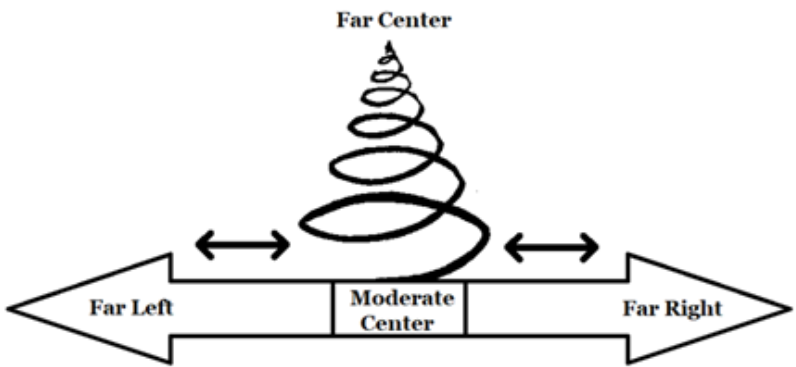The political spectrum runs from Far Left communism to Far Right nationalism. In the Center is liberalism. But what about the Far Center? What does that concept even entail? Is it possible? “Far” makes sense when applied to the Right and Left, but to the Center? How can you be “Far” in the Center? “Far” here would imply going more toward the Center than the Center.
This is symbolized by an increase in the density of resonance. If one recognizes that all positions in the spectrum have some kind of frequency, the Far Center is that position toward the middle which tunes this frequency the finest. This can be thought of as a tight-rope walker who stays nearly perfectly in the center, keeping an almost perfect balance, in comparison to a tight-rope walker who may get by, but with significantly more swinging. The one who keeps better balance is further center, and less wobbly. The Far Center opposes deficiency (communism) and excess (nationalism)—trying to stay swung to one side— as vices, and upholds a place “somewhere near the middle” in an attempt at virtue. Traditions East and West have often held that virtue is a place of balance and Far Centrists hold to the same view. But it wants to do better than liberal republicanism at this.
While it wishes, itself, to stay away from the extremes as extremes,[1] and to remain truly moderate, Far Centrism appreciates the lessons provided by both the Far Left and the Far Right. As the extremes to either side are explored and opened up further, the clarity provided by their lessons allows the Far Center to move further center-ward. Familiarity with the extremes allows the Far Center to better get its footing in the middle. The Far Center draws from the Far Left and the Far Right, but transcends and includes them into a higher existence. The Far Center is naturally characterized by words such as syncretic, integral, compatibilistic, etc.

The Far Center is not like the Moderate Center, which is more or less conservative. The Far Center is revolutionary. But its revolutionary values are libertarian and democratic rather than communist or nationalist, much as the revolutionary values of the American patriots were liberal and republican, rather than aristocratic or monarchist. The Far Center is characterized by an increasingly dense resonance that marks it as a refined position, and not simply more defunct moderation. It does not go Left, Right, nor does it stagnate. It moves forward by way of resonance. In this way, it transcends a one-dimensional spectrum altogether. The Far Center can also be referred to as the deep Center or the revolutionary or radical or transcendent Center, etc. The Far Center holds that moderation is a virtue, but that Moderate Centrists are not truly moderate, but conservative.
While not moderate, the Far Center is patriotic as well as avant-garde. It upholds the old ways until such point that better ones may take their place. Better ways are neither Far Left nor Far Right. They are not Moderate, either. They are historically progressive and libertarian by nature. The Far Center accepts no substitute over liberalism other than libertarianism.
The Far Center, like the Moderate Center, is concerned with the balance of interests. Republican thinkers such as Plato, Aristotle, and James Madison had concerned themselves with matters of balance—even if to benefit an as-yet unbalanced class relationship— but communists and nationalists are extremists. The Far Center recognizes that the current liberal republic is a paradigm that is balanced, yes, but also rigged for the sake of the bourgeoisie. It is characterized as Far Center in its desire to extend the benefits of liberal and republican society to society at large, as in the project of mutualism.[2]
The Moderate Center's demography is bourgeois, but the Far Center's is proletarian and populist. This is from where its progressive elements arise. The Moderate Center is necessarily conservative, wishing to maintain the present institutions with minimal change made to them. The Far Center wishes to economically and politically enfranchise the proletarian and to free the petty bourgeois, into whom the proletarian will be sublated as owner-occupants and owner-operators. The Far Center wishes to further republicanize industry and liberalize property, to promote workplace democracy and the de-monopolization of property.
The Far Left is Postmodernist, the Far Right is Romantic, the Moderate Center is Modernist, but the Far Center is Remodernist.
[1] Far Centrism may include positions such as mutualism, which is both fully socialist and fully liberal (in the classical sense), while straying from state and private control.
[2] Mutualism is classically Left-wing, but I situate mutualism in the Center in today’s politics, owing to the fact that, at least in the context of the United States, classically Right-wing positions, such as monarchism, are fairly non-existent. Nationalism in the United States mostly amounts to paleoconservatism. Also, Chomsky suggests that anarchism is basically the natural historical heir to liberalism, out of which it grew.
Back to Article Index